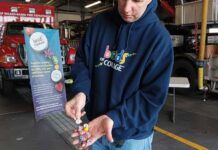Click here to subscribe today or Login.
It was a simple enough picture that told a powerful story we too often forget. Accompanying staff writer Jerry Lynott’s report in Wednesday’s paper about preparation for the looming rain from Tropical Storm Ida, the photo showed a contractor installing concrete barriers to form a “coffer dam” in Laurel Run where a wall along one bank had been removed in anticipation of long-needed replacement.
The goal: to divert water away from the exposed dirt where the wall once stood, eliminating or at least reducing the risk of erosion eating away the ground beneath a city street — or worse, beneath the buildings on that street.
The reminder: Nature never cares about human scheduling. The wall replacement could have been done any time in many years, the depression-era wall had long outlived its own safe use. Sooner or later, parts of it had to be removed and replaced. Ida just happened to hit the region between those two actions.
Nature doesn’t care. It doesn’t check with mayors or governors or the Army Corps of Engineers or contractors or homeowners to see “when is good for you” to have a flood, an ice dam, a sink hole, a tornado. These things and other disasters hit on their own timeline. The best we can do is try to anticipate, to build in precautions against the danger, to maintain those physical efforts like flood gates and creek retaining walls.
But in the end, if Ida tracks a little further north than hoped for and drops five or six inches of rain on the area instead of two or three, our options become rapidly limited. Indeed, there is an old definition of an emergency: It’s when you have no more time to make a choice.
There are times when it feels very much as though we prefer to live with limited choices, or limited time to respond to looming disasters, almost on a dare. This country has developed a terrible habit of putting off regular infrastructure maintenance, replacement or upgrades. We also have a bad habit of allowing unfettered development in places where disaster is almost assured to strike (fault lines, shore lines, flood plains).
Some of those poor choices on construction sites came before the risks were fully known, and the best we can often do is try to disaster-proof the structures after the fact: Require buildings to be earthquake or hurricane resistant, build ever-larger levees along river and creek banks, and put up more floodgates.
Sometimes we opt to defy nature by developing where we know it is unsafe, simply because the profit potential is so high. Sure all those coastal resorts are at risk of flooding every time a tropical storm comes, but there’s so much money to be made in between the hurricanes!
And sometimes, as in the case of the Laurel Run coffer dam, we work with best intentions and good faith to reduce the risks, only to find that, well, nature didn’t call ahead.
By the time you read this, the worst of the rain likely will have stopped and much of any potential damage will have either occurred or been averted. But it behooves us to remember not to leave critical infrastructure deteriorate too much, and not to take existing preparations against disaster for granted.
Nature may not care, but we need to.
— Times Leader








